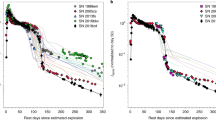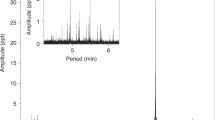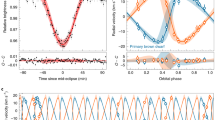Abstract
Our understanding of the evolution of massive stars before their final explosions as supernovae is incomplete, from both an observational and a theoretical standpoint. A key missing piece in the supernova puzzle is the difficulty of identifying and studying progenitor stars. In only a single case—that of supernova SN 1987A in the Large Magellanic Cloud—has a star been detected at the supernova location before the explosion, and been subsequently shown to have vanished after the supernova event1. The progenitor of SN 1987A was a blue supergiant, which required a rethink of stellar evolution models2. The progenitor of supernova SN 2005gl was proposed to be an extremely luminous object3, but the association was not robustly established (it was not even clear that the putative progenitor was a single luminous star). Here we report that the previously proposed3 object was indeed the progenitor star of SN 2005gl. This very massive star was likely a luminous blue variable that standard stellar evolution predicts should not have exploded in that state.
This is a preview of subscription content, access via your institution
Access options
Subscribe to this journal
Receive 51 print issues and online access
$199.00 per year
only $3.90 per issue
Buy this article
- Purchase on Springer Link
- Instant access to full article PDF
Prices may be subject to local taxes which are calculated during checkout



Similar content being viewed by others
References
Gilmozzi, R. et al. The progenitor of SN1987A. Nature 328, 318–320 (1987)
Arnett, W. D., Bahcall, J. N., Kirshner, R. P. & Woosley, S. E. Supernova 1987A. Annu. Rev. Astron. Astrophys. 27, 629–700 (1989)
Gal-Yam, A. et al. On the progenitor of SN 2005gl and the nature of Type IIn supernovae. Astrophys. J. 656, 372–381 (2007)
Humphreys, R. M. & Davidson, K. The luminous blue variables: Astrophysical geysers. Publ. Astron. Soc. Pacif. 106, 1025–1051 (1994)
Schlegel, E. M. A new subclass of Type II supernovae? Mon. Not. R. Astron. Soc. 244, 269–271 (1990)
Filippenko, A. V. Optical spectra of supernovae. Annu. Rev. Astron. Astrophys. 35, 309–355 (1997)
Aldering, G., Humphreys, R. M. & Richmond, M. S. N. 1993J: The optical properties of its progenitor. Astron. J. 107, 662–672 (1994)
Smartt, S. J. et al. Detection of a red supergiant progenitor star of a Type II-plateau supernova. Science 303, 499–503 (2004)
Li, W. et al. Identification of the red supergiant progenitor of supernova 2005cs: Do the progenitors of Type II-P supernovae have low mass? Astrophys. J. 641, 1060–1070 (2006)
Hendry, M. A. et al. SN 2004A: Another Type II-P supernova with a red supergiant progenitor. Mon. Not. R. Astron. Soc. 369, 1303–1320 (2006)
Smartt, S. J., Eldridge, J. J., Crockett, R. M. & Maund, J. R. The death of massive stars - I. Observational constraints on the progenitors of type II-P supernovae. Preprint at 〈http://arxiv.org/abs/0809.0403v2〉 (2008)
Leonard, D. C. et al. An upper mass limit on a red supergiant progenitor for the Type II-plateau supernova SN 2006my. Publ. Astron. Soc. Pacif. 120, 1259–1266 (2008)
Roelofs, G., Bassa, C., Voss, R. & Nelemans, G. On the detection of the progenitor of the type Ia supernova 2007on. Mon. Not. R. Astron. Soc. 391, 290–296 (2008)
Smith, N. et al. SN 2006tf: Precursor eruptions and the optically thick regime of extremely luminous Type IIn supernovae. Astrophys. J. 686, 467–484 (2008)
Salamanca, I. et al. The circumstellar medium of the peculiar supernova SN1997ab. Mon. Not. R. Astron. Soc. 300, L17–L21 (1998)
Maeder, A. & Conti, P. S. Massive star populations in nearby galaxies. Annu. Rev. Astron. Astrophys. 32, 227–275 (1994)
Langer, N. et al. Towards an understanding of very massive stars. A new evolutionary scenario relating O stars, LBVs and Wolf-Rayet stars. Astron. Astrophys. 290, 819–833 (1994)
Smith, N. et al. SN 2006gy: Discovery of the most luminous supernova ever recorded, powered by the death of an extremely massive star like η Carinae. Astrophys. J. 666, 1116–1128 (2007)
Kotak, R. & Vink, J. S. Luminous blue variables as the progenitors of supernovae with quasi-periodic radio modulations. Astron. Astrophys. 460, L5–L8 (2006)
Trundle, C., Kotak, R., Vink, J. S. & Meikle, W. P. S. SN 2005 gj: Evidence for LBV supernovae progenitors? Astron. Astrophys. 483, L47–L50 (2008)
Nadyozhin, D. K. Explosion energies, nickel masses and distances of Type II plateau supernovae. Mon. Not. R. Astron. Soc. 346, 97–104 (2003)
Woosley, S. E., Blinnikov, S. & Heger, A. Pulsational pair instability as an explanation for the most luminous supernovae. Nature 450, 390–392 (2007)
Dessart, L., Hillier, D. J., Gezari, S., Basa, S. & Matheson, T. SN 1994W: an interacting supernova or two interacting shells? Mon. Not. R. Astron. Soc. 394, 21 (2009)
Mazzali, P. A. et al. The metamorphosis of supernova SN 2008D/XRF 080109: A link between supernovae and GRBs/hypernovae. Science 321, 1185–1188 (2008)
Pastorello, A. et al. A giant outburst two years before the core-collapse of a massive star. Nature 447, 829–832 (2007)
Van Dyk, S. D. Supernova impostors: LBV outbursts from the most massive stars. Highlights Astron. 14, 205 (2007)
Puckett, T. & Ceravolo, P. Supernovae 2005gk and 2005gl. IAU Circ. 8615, (2005)
Smith, N. & Owocki, S. P. On the role of continuum-driven eruptions in the evolution of very massive stars and Population III stars. Astrophys. J. 645, L45–L48 (2006)
Acknowledgements
We acknowledge advice from E. Nakar, R. Sari, E. Baron, S. Smartt, M. Modjaz and P. Mazzali, and E. Ofek also for his help with Fig. 1. This work is based on observations with the NASA/ESA Hubble Space Telescope, obtained at the Space Telescope Science Institute, which is operated by the Association of Universities for Research in Astronomy, Inc., for NASA. A.G.-Y. acknowledges support by the Israeli Science Foundation, an EU Seventh Framework Programme Marie Curie IRG fellowship, the Benoziyo Center for Astrophysics, a research grant from the Peter and Patricia Gruber Awards, and the William Z. and Eda Bess Novick New Scientists Fund at the Weizmann Institute.
Author information
Authors and Affiliations
Corresponding author
Supplementary information
Supplementary Information
This file contains Supplementary Notes and Data, Supplementary Table 1, Supplementary Figures 4-6 with Legends and Supplementary References (PDF 396 kb)
Rights and permissions
About this article
Cite this article
Gal-Yam, A., Leonard, D. A massive hypergiant star as the progenitor of the supernova SN 2005gl. Nature 458, 865–867 (2009). https://doi.org/10.1038/nature07934
Received:
Accepted:
Published:
Issue Date:
DOI: https://doi.org/10.1038/nature07934
This article is cited by
-
Quark deconfinement as a supernova explosion engine for massive blue supergiant stars
Nature Astronomy (2018)
Comments
By submitting a comment you agree to abide by our Terms and Community Guidelines. If you find something abusive or that does not comply with our terms or guidelines please flag it as inappropriate.



